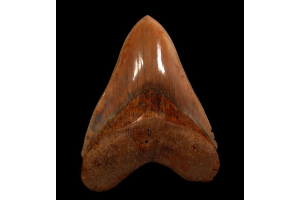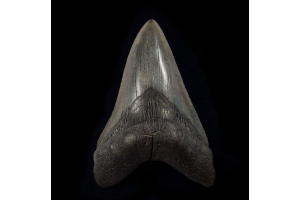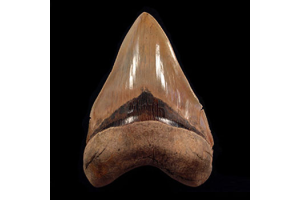Page 3 - Gary Greaser
- - December 04, 2025
Fossil collectors and enthusiasts have long been fascinated by megalodon teeth, but knowing what they’re really worth can be confusing. With sizes ranging from just a few inches to over seven, and prices that vary widely, the value of a megalodon tooth isn't always obvious. As fossil lovers ourselves, we’ve spent a lot of time studying these ancient remnants to understand the many variables that influence their market value. If you’re wondering about megalodon tooth worth, this guide offers a clear and reliable breakdown, based on size, condition, and collector demand.
Size Is the Starting Point
The most immediate factor affecting the price of a megalodon tooth is its size. Typically measured along the longest slant, the majority of commercially available specimens fall between 3 and 5 inches. These mid-range teeth often sell for anywhere between $50- $500, depending on additional features like condition and color.
Larger specimens, especially those exceeding 6 inches, are significantly
- - December 04, 2025
When a man finds a tooth of megalodon in an area most collectors overlook, the discovery forces a shift in how we think about fossil hunting. That single moment speaks to something larger. It challenges the notion that only well-known fossil sites are significant. It reminds us that ancient remnants often lie buried in places where people abandon or ignore them. For fossil collectors, this becomes a real opportunity. This discovery revives questions about land, erosion, timing, and strategy. It opens the door for fresh exploration in spaces we once considered exhausted or unpromising.
Why This Discovery Demands a Fresh Look
Most seasoned collectors follow routines. They search in rivers known for marine fossils or visit places where past discoveries have often happened. That pattern makes sense. These areas build reputations because they deliver. But fossils do not follow public memory. Sediment moves. Water uncovers. Wind and rain reshape the land. What lay hidden ten years ago may now
- - December 04, 2025
Holding a fossilized Megalodon tooth in your hand tells a story that stretches back millions of years. Collectors around the world continue to seek these prehistoric remnants, and among the most talked about sources today are fossils sourced from Indonesia. Interest in Indonesian Megalodon teeth is growing steadily, not just for their distinctive appearance but also for their increasing presence in the global fossil market. As more collectors show interest, the question naturally arises. Can buyers trust local Indonesian dealers to offer authentic Megalodon teeth?
Why Indonesia Attracts Attention in the Fossil Market?
Collectors pursue fossils that offer both visual impact and authentic backstories. In Indonesia, local diggers uncover Megalodon teeth in riverbanks and sediment-rich areas. These regions often preserve the teeth well, producing specimens with strong enamel and rare color variations. Over time, these locations have become key sources for large and intact fossil teeth. Collectors
- - December 04, 2025
If you collect prehistoric shark teeth, the dream piece is obvious: the largest megalodon tooth you can find. It looks monumental. It anchors any display. And yes, it usually carries a premium. But is a giant tooth worth it for you? Here’s a clear, buyer-first guide grounded in what Buried Treasure Fossils actually offers collectors and dealers.
What Largest Megalodon Really Means
Collectors use crown height (measured along the slant) to compare teeth. Once a tooth crosses roughly the 6-inch threshold, most consider it “giant” or “trophy-grade.” Larger specimens exist, but each extra fraction of an inch becomes exponentially rarer and pricier. On the site, you’ll see that quality, size, and condition drive desirability; the biggest, best-preserved pieces are the rarest and typically command the most money.
Why the Largest Megalodon Tooth Commands a Premium
A tooth isn’t valuable just because it’s big. It’s the full package:
● Size: Bigger almost always costs more. True giants are
- - December 04, 2025
Many fossil hunters arrive in Florida with one goal in mind. They want to find a real megalodon tooth buried beneath the soil or riverbed. They bring their gear, they follow advice, and they work for hours, sometimes days. But often, they leave with empty bags and more profound questions. The issue rarely lies in their effort. The real challenge begins with knowing where to look and how to read the land. If you want to know where to find megalodon teeth in Florida, you must first understand why your current approach might not work.
How Ancient Florida Preserved the Megalodon’s Legacy?
Millions of years ago, Florida sat beneath a shallow sea. Megalodon, the largest shark that ever lived, swam these waters and left behind rows of massive teeth. Over time, these teeth settled into ancient seabeds that slowly turned into fossil layers. Today, erosion and water flow expose these layers in certain parts of the state. But not every place reveals its history equally. Some spots still hold treasure.
- - December 04, 2025
The allure of owning a megalodon tooth is undeniable. These massive fossilized remains, once belonging to the largest predatory shark in history, carry immense historical, scientific, and collector value. As interest grows, so does the number of replicas and misidentified specimens on the market. We’ve handled countless authentic fossils, including Venice Beach megalodon teeth, and know exactly what separates the real from the fake. Whether you’re a seasoned collector or buying your first fossil, this guide will walk you through everything you need to evaluate a tooth's authenticity with confidence.
Understanding the Basics: What Makes a Tooth Genuine?
Authentic megalodon teeth are fossilized remains, often millions of years old, typically discovered in marine sediments. These teeth vary in size, coloration, and condition, depending on their location of discovery and the preservation conditions.
Megalodon teeth can range from under 3 inches to over 7 inches in length. The most desirable
- - December 04, 2025
The ocean has always kept its secrets well. From the hush of the deep blue to the fossils hidden in ancient sands, every discovery reveals whispers of what once ruled the seas. Among these relics lies something so small yet so astonishing—a baby megalodon tooth. Though miniature compared to the adult’s formidable size, it carries an ancient story of beginnings, evolution, and oceanic dominance.
It’s fascinating to think that even the tiniest fossil fragment can hold echoes of creatures that once swam the waters millions of years ago. This isn’t merely a collector’s find—it’s a window into the prehistoric world.
Tracing the Origin of a Giant
Imagine holding a piece of history between your fingers, one that predates humans by millions of years. A megalodon, often hailed as the largest shark that ever existed, began its life much like any other creature—in miniature form. Its early teeth, more minor yet intricately detailed, hint at the massive predator it would become.
Every ridge, curve,
- - December 04, 2025
Long before theme parks and beach vacations, Florida’s warm, shallow seas were home to some of the most fascinating creatures ever to exist—including the mighty Megalodon, the largest shark that ever lived. Today, the Sunshine State remains one of the best places to uncover its ancient secrets. If you’ve ever wondered where to find megalodon teeth in Florida, you’re in luck—Florida’s sandy coasts and riverbeds are full of prehistoric treasures waiting to be discovered.
The Ancient Ocean Beneath Florida’s Feet
Millions of years ago, Florida was completely underwater. The warm coastal seas were teeming with life—giant sharks, whales, sea turtles, and coral reefs filled the ancient ocean. Over time, as sea levels changed and sediments settled, these creatures became buried beneath layers of sand, mud, and limestone. Their bones and teeth turned into fossils, perfectly preserved snapshots of Earth’s distant past.
Because of this unique geological history, Florida’s soil and river systems are
- - December 04, 2025
At our fossil collection, we take pride in offering specimens that capture the timeless beauty of Earth’s ancient past. Among them, the Otodus megalodon from Indonesia holds a special place. These remarkable fossils have fascinated us with their exceptional preservation, color, and structure.
Each specimen allows us to glimpse into a prehistoric world where colossal predators once ruled the oceans. Their natural artistry and geological perfection make them among the most captivating fossils we offer.
Geological Origin and Preservation
The story of Indonesian Otodus megalodon teeth begins deep within the limestone formations of West Java. These fossils are often recovered from the Bentang Formation, a geological layer that dates to the Middle Miocene epoch, around 10 to 15 million years ago. Within this limestone, the teeth have remained protected for millions of years, allowing them to retain their detailed structure and natural sheen.
Because these fossils were buried under stable
- - December 04, 2025
Buying or grading a Megalodon tooth should feel straightforward. On Buried Treasure Fossils, you can judge a specimen using the same signals you see in the listings: size, condition features, locality, eye appeal, and authenticity. The Megalodon category also groups teeth by size tiers and locations, which makes side-by-side comparisons easy before you buy.
Size: The First Quality Signal
Size draws the eye first. Megalodon teeth can exceed 7 inches, but most legitimate specimens rarely exceed 6 to 6½ inches. The site even has a dedicated “6 inch” grouping to help you find showpieces quickly. If two teeth have similar conditions, the larger tooth typically commands the premium.
Collectors also notice the presentation. Most 5-inch-plus teeth on the site come with a custom stand. That matters for heavy crowns that should be supported in a display.
Condition: What the Details Reveal
Condition tells you how well a tooth survived time and transport. Listings highlight these details, and you can







